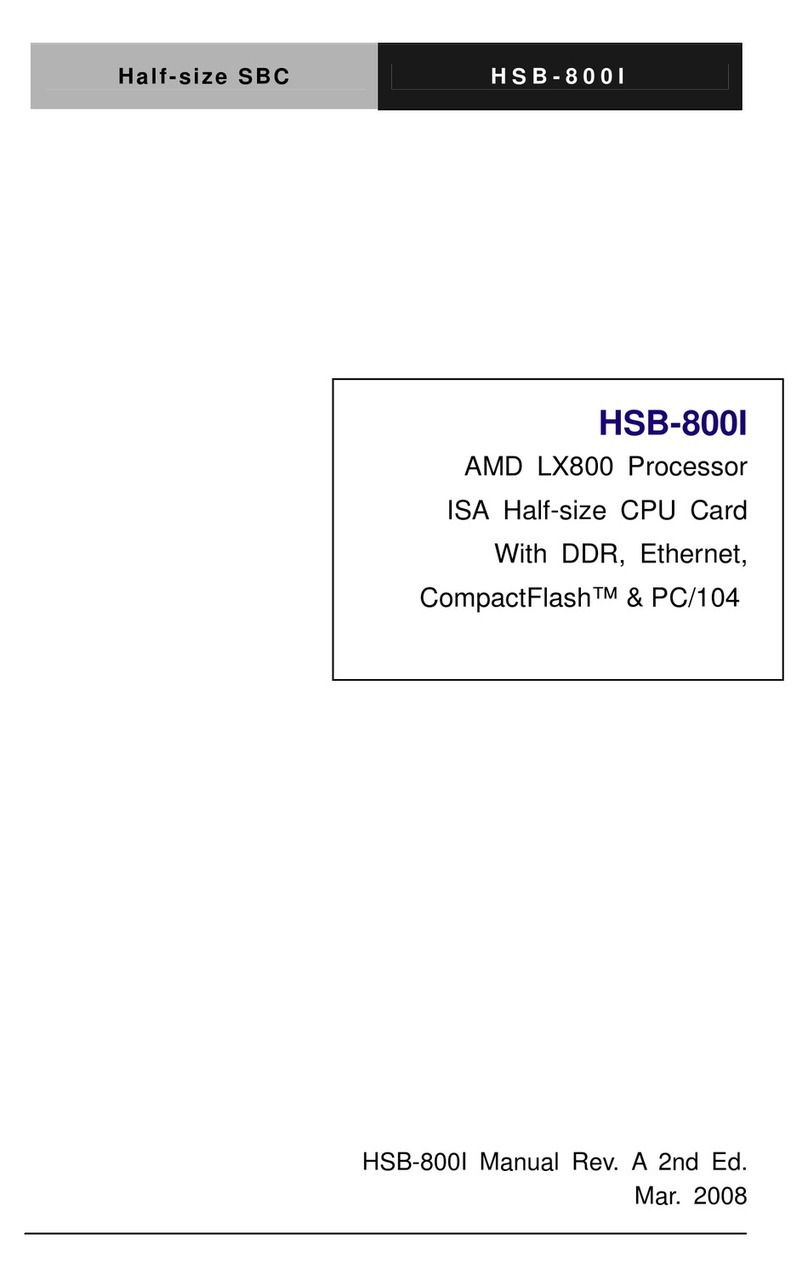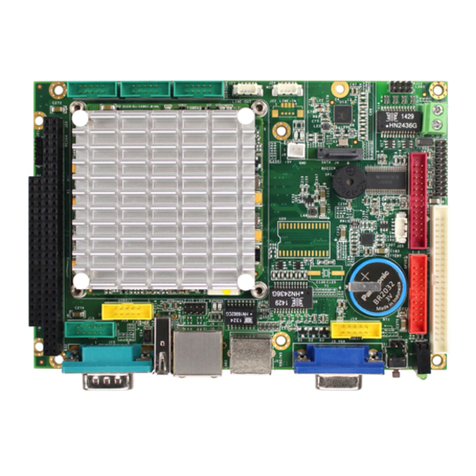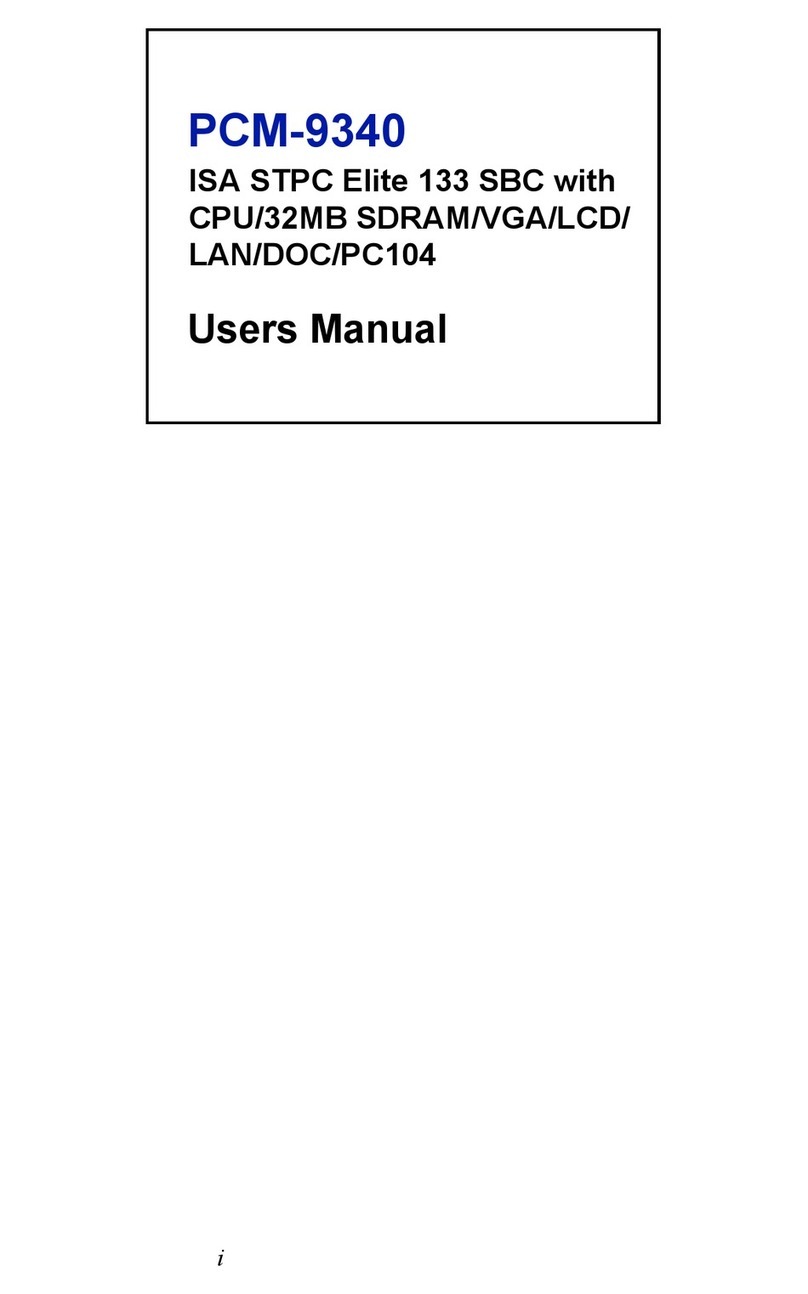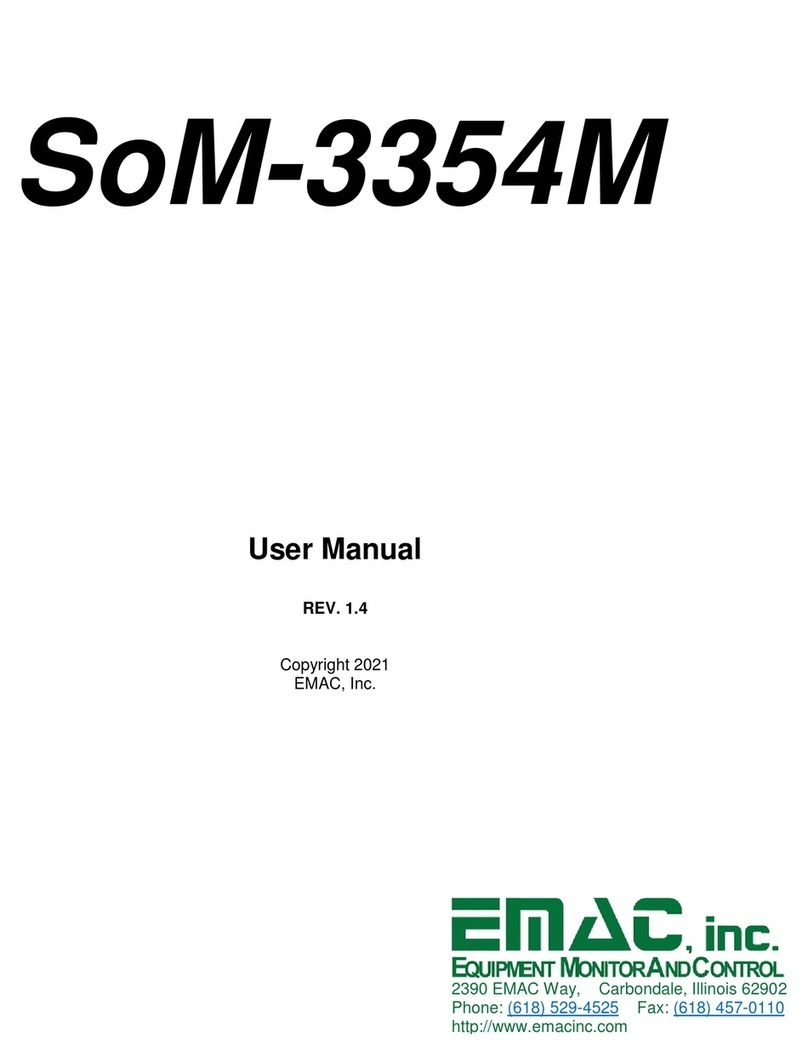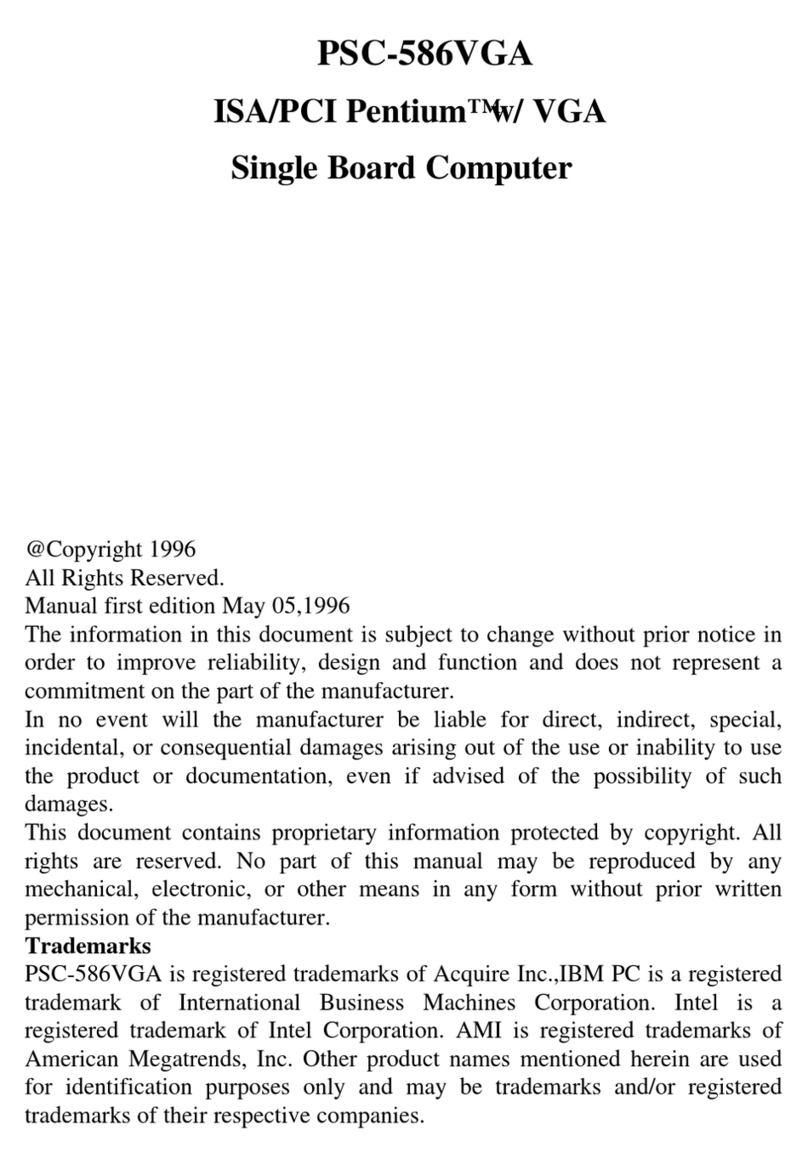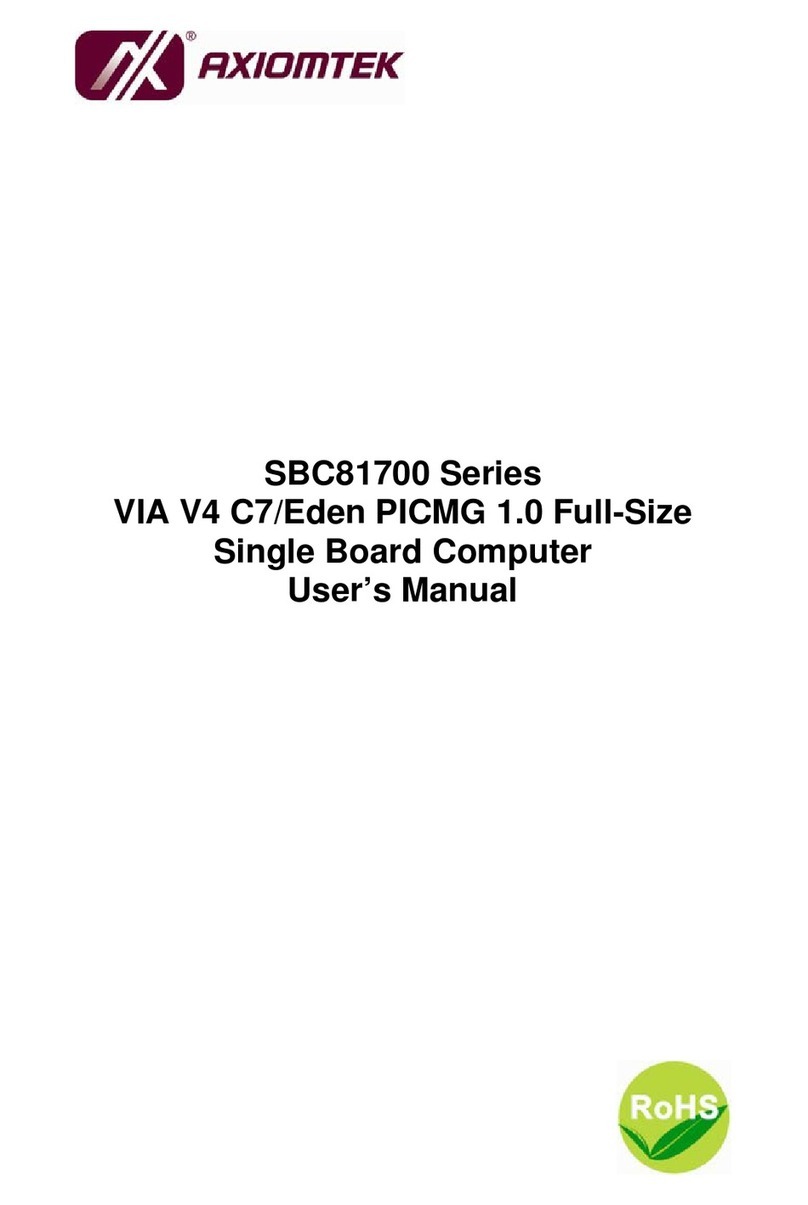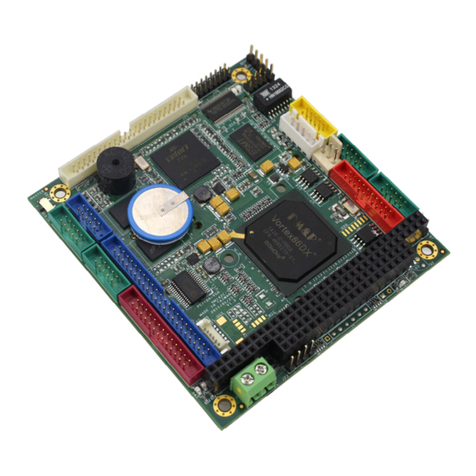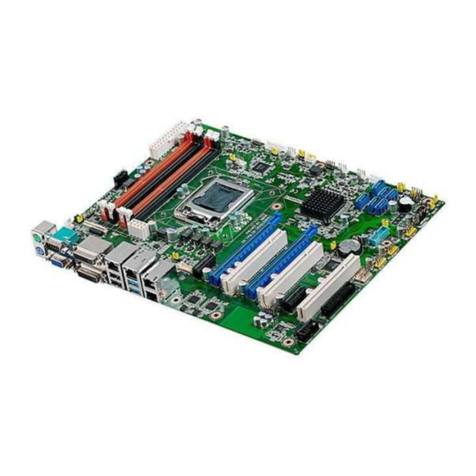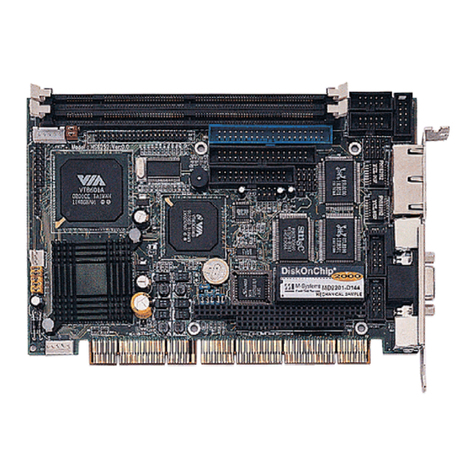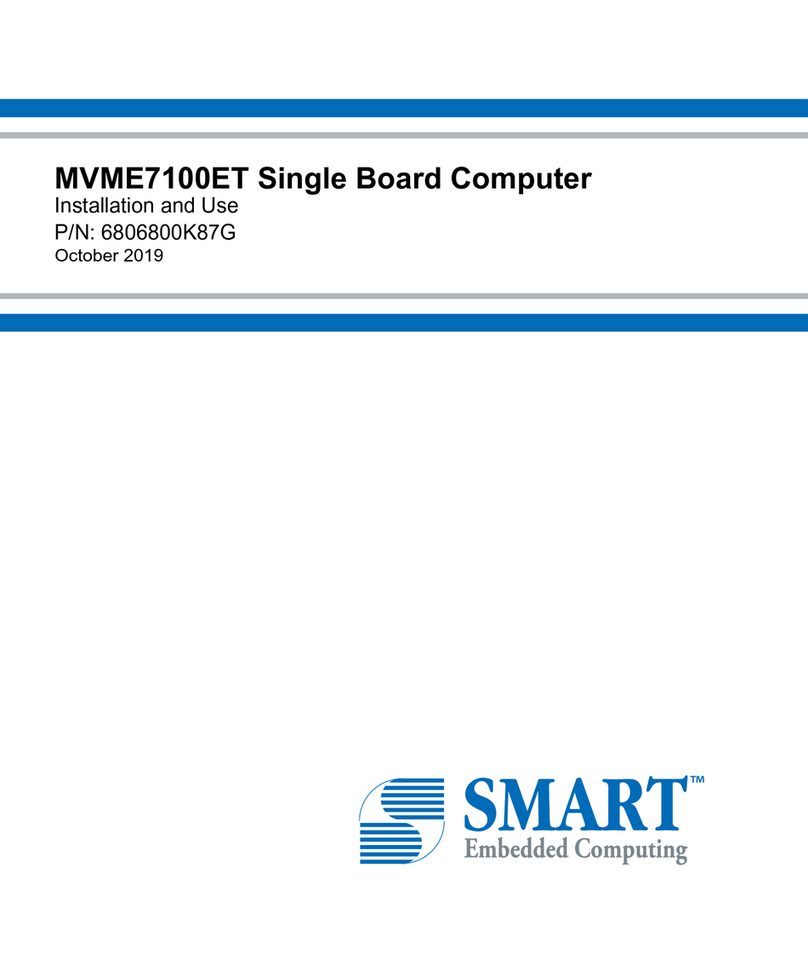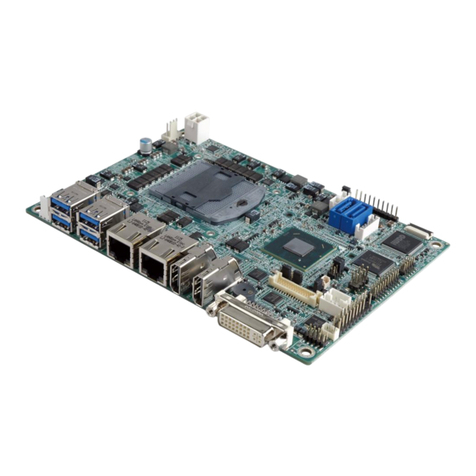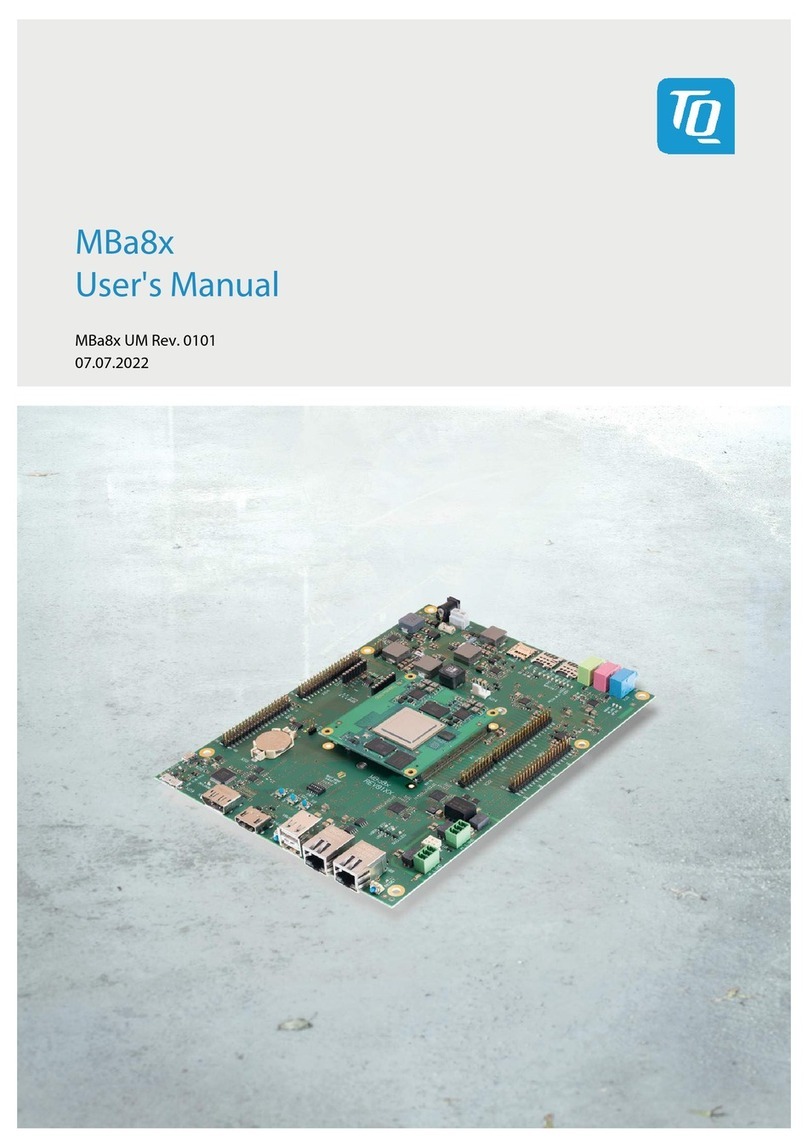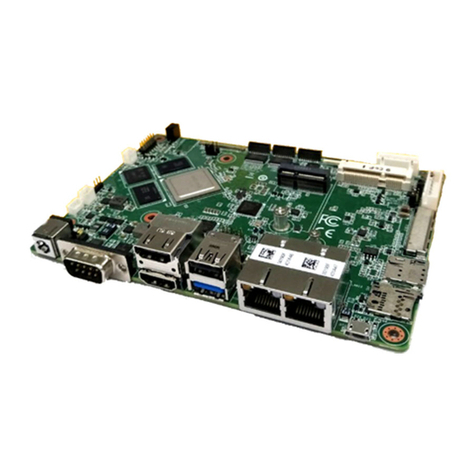EMAC CFC2 User manual

PCI-6871
PCI Eden400 Half-sized SBC
with SODIMM/VGA
LCD/LVDS/LAN and CFC2
Users’ Manual

PCI-6871 User’s Manual ii
Copyright
This document is copyrighted, © 2002. All rights are reserved. The orig-
inal manufacturer reserves the right to make improvements to the prod-
ucts described in this manual at any time without notice.
No part of this manual may be reproduced, copied, translated or transmit-
ted in any form or by any means without the prior written permission of
the original manufacturer. Information provided in this manual is
intended to be accurate and reliable. However, the original manufacturer
assumes no responsibility for its use, nor for any infringements upon the
rights of third parties that may result from such use.
Acknowledgements
Award is a trademark of Award Software International, Inc.
VIA is a trademark of VIA Technologies, Inc.
IBM, PC/AT, PS/2 and VGA are trademarks of International Business
Machines Corporation.
Intel and Pentium are trademarks of Intel Corporation.
Microsoft Windows® is a registered trademark of Microsoft Corp.
RTL is a trademark of Realtek Semi-Conductor Co., Ltd.
ESS is a trademark of ESS Technology, Inc.
UMC is a trademark of United Microelectronics Corporation.
SMI is a trademark of Silicon Motion, Inc.
Creative is a trademark of Creative Technology LTD.
All other product names or trademarks are properties of their respective
owners.
For more informationon this and other EMAC products,please visit
our websiteat:http://www.emacinc.com
For technical support and service, please visit our support website at:
http://www.emacinc.com/support/
This manual is for the PCI-6871.
Part No. 2006687110
1st Edition,Dec, 2002

iii
Packing List
Before you begin installing your card, please make sure that the following
materials have been shipped:
• 1 ea. PCI-6871 all-in-one single board computer
• 1 ea. startup manual
• CD-ROM or disks for utility, drivers, and manual (in PDF format)
• 1 ea. power cable p/n: 1703080101
• 1 ea. PS/2 KB/M cable p/n: 1700060202
• 1 ea. Printer cable p/n:1700260250
• 1 ea. FDD cable p/n:1701340603
• 1 ea. EIDE cable p/n:1701400452
If any of these items are missing or damaged, contact your distributor or
sales representative immediately.
Model No. List Description
PPCI-6871F-J0A1 PCI Eden400 Half-sized SBC with SODIMM/VGA
LCD/LVDS/LAN and CFC2
Additional Information and Assistance
1.Visit themanufacturer's web site at www.emacinc.comwhere you can
find the latest information about the product.
2.Contactyour distributor,sales representative, or customer
service center for technical support if you need additional assistance.
Please have the following information ready before you call:
• Product name and serial number
• Description of your peripheral attachments
• Description of your software (operating system, version, application
software, etc.)
• A complete description of the problem
• The exact wording of any error messages

PCI-6871 User’s Manual iv

Table of Contents
v
Contents
Chapter 1 General Information ........................................1
1.1 Introduction ....................................................................... 2
1.2 Features ............................................................................. 3
1.3 Specifications .................................................................... 3
1.3.1 Standard SBC Functions................................................. 3
1.3.2 VGA/LCD/LVDS Interface............................................ 4
1.3.3LVDS: Supports 2 Channel LVDS interface................4
1.3.4 PCI bus Ethernet interface .............................................. 4
1.3.5 Mechanical and Environmental ...................................... 4
1.4 Board layout: dimensions.................................................. 5
Chapter 2 Installation ........................................................7
2.1 Jumpers.............................................................................. 8
2.2 Connectors......................................................................... 8
2.3 Locating jumpers............................................................. 10
2.4 Locating Connectors ....................................................... 11
2.5 Setting Jumpers ............................................................... 12
2.6 Clear CMOS (JP1) .......................................................... 13
2.7 Installing system memory (SODIMMs).......................... 14
2.7.1 Installing SODIMMs .................................................... 14
2.8 IDE, CDROM hard drive connector (CN1, CN7)........... 15
2.8.1 Connecting the hard drive............................................. 16
2.9 Solid State Disk............................................................... 16
2.9.1 CompactFlash (CN28) .................................................. 16
2.10 Floppy drive connector (CN6) ........................................ 16
2.10.1 Connecting the floppy drive ......................................... 17
2.11 Parallel port connector (CN2) ......................................... 17
2.12 Keyboard and PS/2 mouse connector (CN25) ................ 17
2.13 Power & HDD LED, Reset (CN13, CN8) ...................... 18
2.13.1 Power & HDD LED (CN13) ........................................ 18
2.13.2 Reset switch (CN8)....................................................... 18
2.14 Power connectors (CN11, FAN1) ................................... 18
2.14.1 Main power connector, +5 V, +12 V (CN11).............. 18
2.14.2 CPU Fan power supply connector (FAN1)................... 18
2.15 ATX power control connector (CN3, CN5).................... 19
2.15.1 ATX feature (CN3) and soft power switch (CN5) ....... 19
2.16 IR connector (CN9)......................................................... 20
2.17 Audio interfaces (CN10) ................................................. 20
2.18 COM port connector (CN19, CN20)............................... 20
2.18.1 COM2 RS-232/422/485 setting (JP3)........................... 20
2.19 VGA/LCD/LVDS interface connections ........................ 20
2.19.1 CRT display connector (CN12) .................................... 21

vi
2.19.2 Flat panel display connector (CN18) ............................ 21
2.19.3 Extension flat panel connector (CN17) ........................ 21
2.19.4 LVDS LCD panel connector (CN21) ........................... 21
2.19.5 Panel type selection (S1)............................................... 22
2.20 Ethernet configuration..................................................... 22
2.20.1 100Base-T connector (CN15)....................................... 23
2.20.2 Network boot ................................................................ 23
2.20.3 LAN controller power select (JP2) ............................... 23
2.21 Watchdog timer configuration ........................................ 23
2.21.1 Watchdog timer action (JP4) ........................................ 23
2.22 USB connectors (CN4, CN23)........................................ 24
Chapter 3 Software Configuration .................................25
3.1 Introduction ..................................................................... 26
3.2 Connections to Three Standard LCDs............................. 27
3.2.1 Connections to (640 x 480 TFT color LCD) ............... 27
3.2.2 Connections to (1024 x 768 TFT color LCD) ............. 28
3.2.3 Connections to (800 x 600 TFT color LCD) ............... 29
3.3 Ethernet software configuration ...................................... 30
Chapter 4 Award BIOS Setup.........................................33
4.1 System test and initialization........................................... 34
4.1.1 System configuration verification................................. 34
4.2 Award BIOS setup .......................................................... 35
4.2.1 Entering setup .............................................................. 35
4.2.2 Standard CMOS Features setup.................................... 36
4.2.3 Advanced BIOS Features setup .................................... 37
4.2.4 Advanced Chipset Features setup ................................. 38
4.2.5 Integrated Peripherals ................................................... 39
4.2.6 Power Management Setup ............................................ 39
4.2.7 PnP/PCI Configurations................................................ 40
4.2.8 PC Health Status ........................................................... 40
4.2.9 Frequency/Voltage Control........................................... 41
4.2.10 Load Optimized Defaults.............................................. 42
4.2.11 Set Password ................................................................. 42
4.2.12 Save & Exit Setup......................................................... 43
4.2.13 Exit Without Saving...................................................... 44
Chapter 5 PCI SVGA Setup ............................................45
5.1 Introduction ..................................................................... 46
5.1.1 Chipset .......................................................................... 46
5.1.2 Display memory............................................................ 46
5.1.3 Display types................................................................. 46
5.1.4 Dual/Simultaneous Display .......................................... 47
5.2 Installation of the SVGA Driver ..................................... 48

Table of Contents
vii
5.2.1 Installation for Windows 95 ......................................... 48
5.2.2 Installation for Windows 98/Me ................................... 52
5.2.3 Installation for Windows NT ........................................ 57
5.2.4 Installation for Windows 2000 ..................................... 62
5.2.5 Installation for Windows XP ........................................ 67
5.3 Further Information......................................................... 73
Chapter 6 Audio Setup.....................................................75
6.1 Introduction ..................................................................... 76
6.2 DOS utilities.................................................................... 76
6.2.1 VIA Sound Blaster Pro compatible set up program ..... 76
6.2.2 VIA Sound Blaster Installation..................................... 76
6.3 Driver installation............................................................ 77
6.3.1 Before you begin........................................................... 77
6.3.2 Windows 95/98 drivers................................................. 77
6.3.3 Windows NT drivers..................................................... 85
6.3.4 Windows 2000 Drivers ................................................. 88
Chapter 7 PCI Bus Ethernet Interface...........................93
7.1 Introduction ..................................................................... 94
7.2 Installation of Ethernet driver ......................................... 94
7.2.1 Installation for MS-DOS and Windows 3.1.................. 94
7.2.2 Installation for Windows 98 ......................................... 95
7.2.3 Installation for Windows 2000 ..................................... 98
7.2.4 Installation for Windows NT ...................................... 103
7.3 Further information ....................................................... 109
Appendix A Programming the Watchdog Timer ...........111
A.1 Supported Input Timing Modes .................................... 112
Appendix B Installing PC/104 Modules ..........................115
Appendix C Pin Assignments ...........................................121
C.1 CPU Fan Power Connector (FAN 1)............................. 122
C.2 Ethernet 10/100Base-T Connector (CN15)................... 122
C.3 Audio Connector (CN10) .............................................. 123
C.4 Main Power Connector (CN11) .................................... 124
C.5 Keyboard and PS/2 Mouse Connector (CN25) ............. 125
C.6 Floppy Disk Drive Connector (CN6) ............................ 126
C.7 IDE Hard Drive Connector (CN1, CN7) ...................... 127
C.8 Parallel Port Connector (CN2) ...................................... 128
C.9 HDD, PWR LED CON & WDT output (CN13)........... 129
C.10 Reset Button Connector (CN8) ..................................... 129
C.11 USB Connector (CN20, CN28)..................................... 130
C.12 LCD Inverter Backlight Connector (CN27).................. 130
C.13 IR Connector (CN9) ...................................................... 131

viii
C.14 CRT Display Connector (CN12)................................... 131
C.15 Flat Panel Connector (CN18)........................................ 132
C.16 Extended Flat Panel Display Connector (CN17) .......... 133
C.17 LCD Signal Mapping .................................................... 134
C.18 LVDS Connector (CN21).............................................. 135
C.19 COM Port Connector (CN19, CN20)............................ 136
C.20 CompactFlash Card Connector (CN28) ........................ 137
C.21 ATX Power Feature Connector (CN3).......................... 138
C.22 LCD Backlight Connector (CN24) ............................... 138
C.23 External Keyboard Connector (CN26).......................... 139
Appendix D System Assignments .....................................141
D.1 System I/O Ports............................................................ 142
D.2 1st MB memory map..................................................... 143
D.3 DMA channel assignments............................................ 143
D.4 Interrupt assignments .................................................... 144
Appendix E Optional Extras for the PCI-6871...............145
E.1 Optional USB cable (CN20) ......................................... 146
E.2 ATX Power Control Cable............................................ 146
E.3 Audio module................................................................ 146

1 Chapter 1 General Information
1
General Information
This chapter gives background
information on the PCI-6871.
Sections include:
• Introduction
• Features
• Specifications
• Board layout and dimensions
CHAPTER

PCI-6871 User’s Manual 2
Chapter 1 Introduction
1.1 Introduction
The new PCI-6871is a half-sized CPU card with onboardVIA
Eden400 C3 EBGA fanless CPU. The VIA Eden processor uses advanced
0.13µ CMOS technology with 128KB L1 cache memory and 64KB L2
cache memory on die. This board with Eden400 CPU can operate without
a fan at temperatures up to 60° C (140° F) and typically consumes under
14 Watts while supporting numerous peripherals. This SBC includes a 4X
AGP controller, a PCI Ethernet interface, and 36-bit TTL interface. Its
design is based on the half-sized CPU card and supports PCI bus expan-
sion. Other on-board features include an FDD, LPT, 4 USBs, and 2 serial
ports. PCI-6871 supports AC97 audio with the addition of the optional
PCM-231A-00A1 audio module. This product uses a VIA VT8606
"TwisterT" chip with Integrated Savage4 2D/3D/Video Accelerator and
supports 4X AGP VGA/LCD interface and up to 32 MB frame buffer
using system memory. The PCI-6871 supports one 10/100Mbps Ethernet
connection with an onboard RJ-45 connector, and is effective for use as a
firewall, VPN, or other communication device.

3 Chapter 1 General Information
1.2 Features
• Embedded low power VIA Eden C3 EGBA 400MHz processor
• Half-sized CPU card with PCI golden finger
• Fanless operation at 60° C.
• 1 onboard RJ-45 connector supports 10/100Base-T Ethernet
• 4X AGP graphics for high performance applications
• Supports PC/104
• Supports wake on LAN
• Supports wake on Modem
• Supports LCD backlight turn-off function
1.3 Specifications
1.3.1 Standard SBC Functions
•CPU: VIA C3 fanless EBGA 400MHz processor
•System chipset: VIA VT8606 "TwisterT" +VT82C686B
•BIOS: Award 256 KB Flash memory
•System memory: Two 144-pin SODIMM sockets (on the backside)
accept 32 MB up to 512MBx2 (total 1024MB) SDRAM
•2nd cache memory: 64KB on the C3 fanless EBGA 400MHz pro-
cessor
•FDD interface: Supports up to two FDDs
•Serial ports: Two serial ports:
COM1: RS-232
COM2: RS-232/422/485
•Parallel port: Parallel port supports SPP/EPP/ECP mode

PCI-6871 User’s Manual 4
•Keyboard/mouse connector: Supports standard PC/AT keyboard
and a PS/2 mouse
•Power management: Supports power saving modes including Nor-
mal/Standby/Suspend modes. APM 1.2 compliant
•Watchdog timer: 62 level timer intervals
•USB: Four universal serial bus ports
•PC/104 expansion: PC/104 connector for ISA control board
•Solid State Disk: Supports one 50-pin socket for CFC type I/II
1.3.2 VGA/LCD/LVDS Interface
•
Chipset:
VIA TwisterT chip with integrated Savage4 2D/3D/Video Accelerator
•
Frame buffer:
Supports 8/16/32 MB frame buffer with system memory
• Interface: 4X AGP VGA/LCD interface, Support for 9, 12, 15, 18, 24,
36 bit TFT and optional 16- or 24-bit DSTN panel
• Display mode: CRT Modes: 1280 x 1024@32bpp (60Hz), 1024 x 768
@ 32bpp (85 Hz); LCD/Simultaneous Modes: 1280 x 1024 @16bpp
(60 Hz), 1024 x 768 @16bpp (60Hz)
1.3.3 LVDS: Supports 2 Channel (2 x 18 bit) LVDS interface
•
Chipset:
VIA VT8606T (TwisterT)
1.3.4 PCI bus Ethernet interface
• Chipset: REALTEK RTL8139 Ethernet controller
• Ethernet interface: IEEE 802.3U compatible 100/10Base-T interface.
Includes software drivers and boot ROM
•
Wake-on-LAN:
Supports wake-on-LAN function with ATX power control
1.3.5 Mechanical and Environmental
• Dimensions (L x W): 185 x 122 mm (7.28” x 4.80”)
• Power supply voltage:
+5 V ±5%, +12V ±5%
• Power requirements:
Max: 10.33A @ +5V,205mA@+12V
(with 128 MB SDRAM,VIA C3-400MHz CPU)
Typical: 2.37A @ +5V,34.02mA@+12V
(with 256 MB SDRAM,VIA C3-400MHz CPU)
• Operating temperature: 0 ~ 60°C (32 ~ 140°F)
• Weight: 0.27 kg (weight of total package)

5 Chapter 1 General Information
1.4 Board layout: dimensions
Figure 1.1: Board layout: dimensions (component side)
I
+
PCI-6871 REV.A1

PCI-6871 User’s Manual 6
Figure 1.2: Board layout: dimensions (solder side)
+
PCI-6871 REV.A1

7 Chapter 2 Installation
2
Installation
This chapter explains the setup procedures
of PCI-6871 hardware, including instruc-
tions on setting jumpers and connecting
peripherals, switches and indicators. Be
sure to read all safety precautions before
you begin the installation procedure.
CHAPTER

PCI-6871 User’s Manual 8
Chapter 2 Installation
2.1 Jumpers
The PCI-6871 has a number of jumpers that allow you to configure your
system to suit your application. The table below lists the functions of the
various jumpers.
2.2 Connectors
On-board connectors link the PCI-6871 to external devices such as hard
disk drives, a keyboard, or floppy drives. The table below lists the func-
tion of each of the board’s connectors.
Table 2.1: Jumpers
Label Function
JP1 CMOS clear
JP2 LAN power select
JP3 RS-232/422/485 select
JP4 Watch-Dog output selct
S1 Panel type select
Table 2.2: Connectors
Label Function
CN1 Primary IDE
CN2 LPT
CN3 ATX Power feature connector
CN4 USB1,2
CN5 PWR_SW
CN6 Floppy
CN7 Secondary IDE
CN8 Reset

9 Chapter 2 Installation
CN9 IR CON
CN10 Audio I/F
CN11 MAIN PWR CON
CN12 D-SUB VGA
CN13 HDD, PWR LED CON & WDT Output
CN14 DIO CON
CN15 LAN RJ45 CON
CN16 PC104
CN17 LCD CON2 (10*2)
CN18 LCD CON1 (20*2)
CN19 COM1
CN20 COM2
CN21 LVDS CON
CN23 USB3,4
CN24 LCD backlight
CN25 PS/2 KB/MS
CN26 EXT_KB
CN27 LCD INV PWR
CN28 CF CON
FAN1 CPU fan power
Table 2.2: Connectors

PCI-6871 User’s Manual 10
2.3 Locating jumpers
Figure 2.1: Jumper locations
+
PCI-6871 REV.A1
I

11 Chapter 2 Installation
2.4 Locating Connectors
Figure 2.2: Connectors (component side)
PCI-6871 REV.A1
+
I

PCI-6871 User’s Manual 12
2.5 Setting Jumpers
You may configure your card to match the needs of your application by
setting jumpers. A jumper is a metal bridge used to close an electric cir-
cuit. It consists of two metal pins and a small metal clip (often protected
by a plastic cover) that slides over the pins to connect them. To “close” a
jumper, you connect the pins with the clip. To “open” a jumper, you
remove the clip. Sometimes a jumper will have three pins, labeled 1, 2
and 3. In this case you would connect either pins 1 and 2, or 2 and 3.
The jumper settings are schematically depicted in this manual as follows:.
A pair of needle-nose pliers may be helpful when working with jumpers.
If you have any doubts about the best hardware configuration for your
application, contact your local distributor or sales representative before
you make any changes.
Generally, you simply need a standard cable to make most connections.
open closed closed 2-3
open closed closed 2-3
This manual suits for next models
3
Table of contents
Other EMAC Single Board Computer manuals
Popular Single Board Computer manuals by other brands
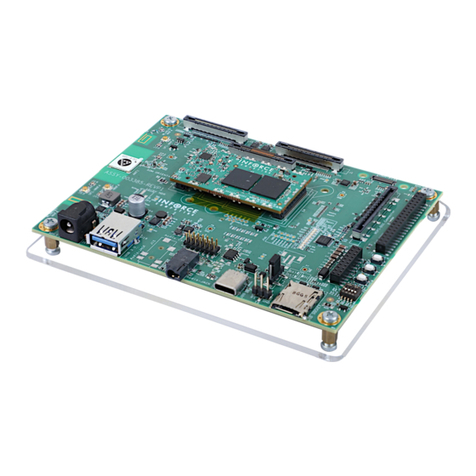
inforce
inforce 6502 quick start guide

StarFive
StarFive VisionFive 2 quick start guide
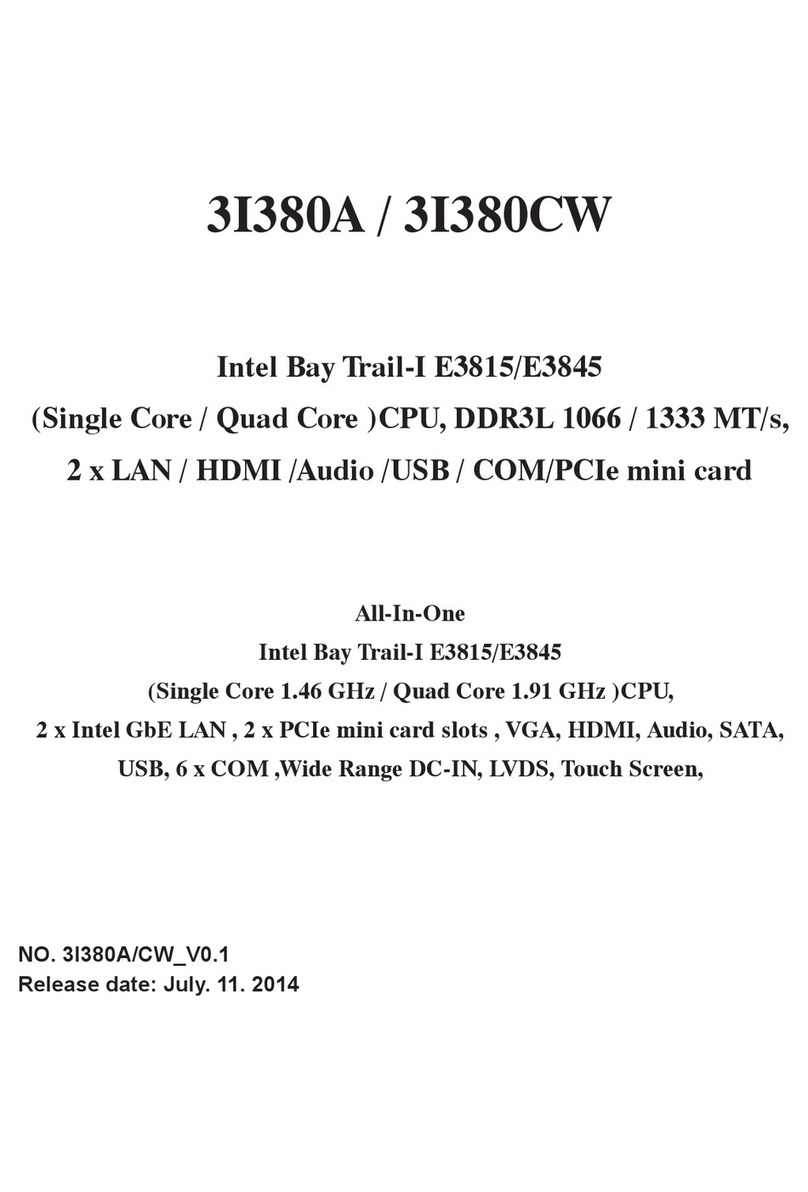
Lex Computech
Lex Computech 3I380A user manual
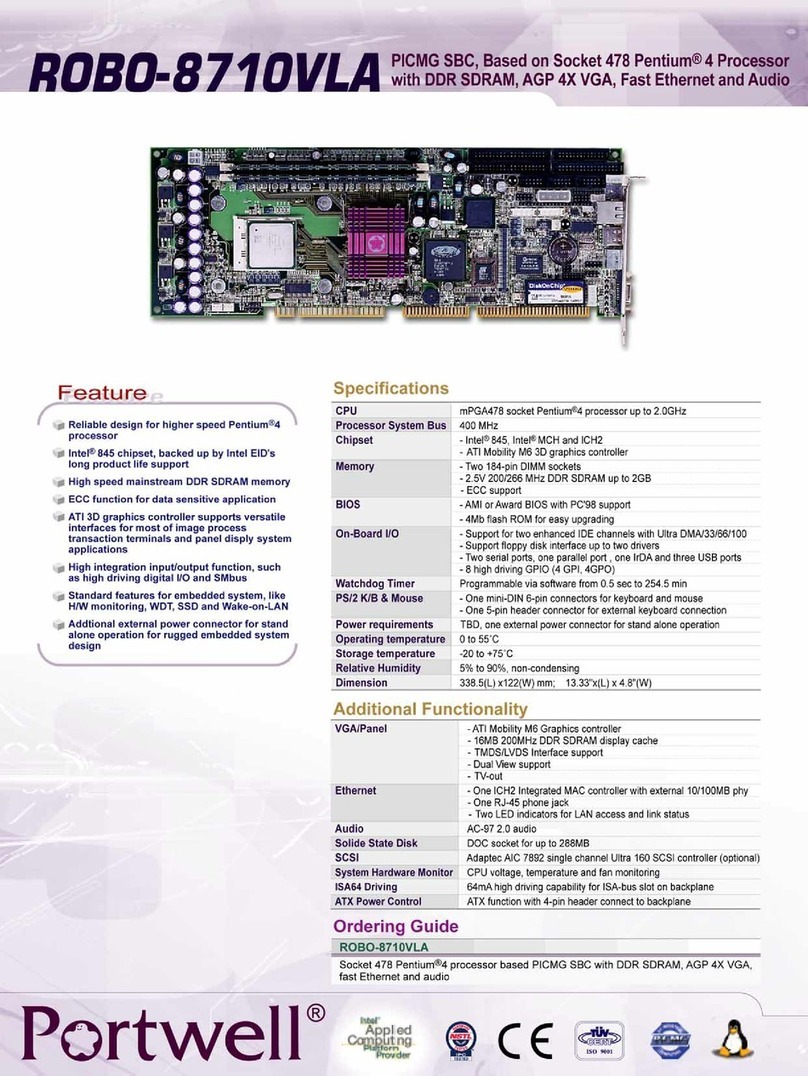
Portwell
Portwell ROBO-8710VLA user manual

Advantech
Advantech RSB-3710 user manual
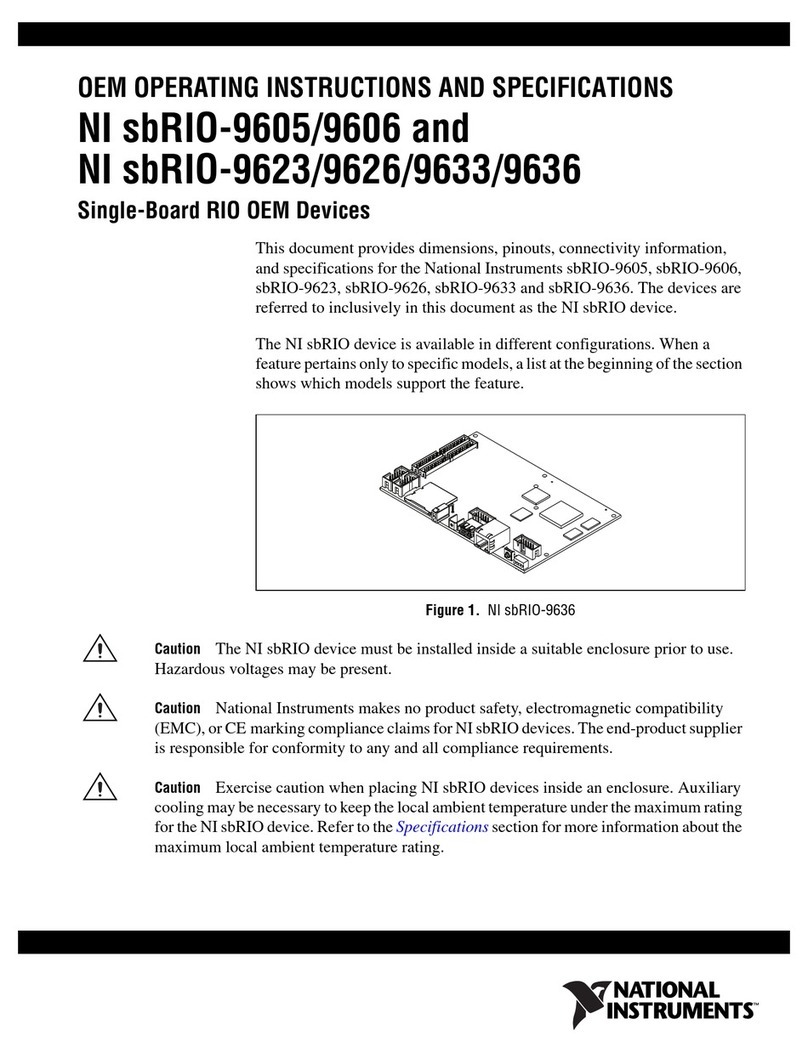
National Instruments
National Instruments sbRIO-9605 Operating instructions and specifications

